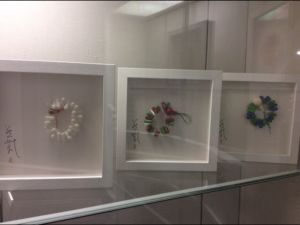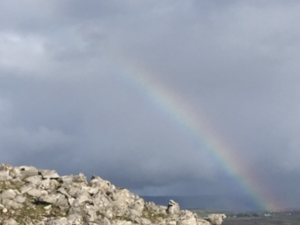When Alison visited the exhibition A Quest for Wellness – Contemporary Chinese Art by Zhang Yanzi at the Museum of East Asian Art in Bath, she learn that in Chinese mythology rainbows are a symbol of mending!
When the heaven was damaged, goddess Nuwa melted 5 coloured stones to patch up the sky which became the rainbow (Zhang Yanzi, 2018). Coloured capsules, bunched together like a rainbow around a wrist, are modern assurance to restore health.

In Celtic tradition the rainbow is a symbol of fertility.In Norse, Navajo and Maori mythology rainbows are bridges between two world worlds – our world and a world beyond our realm.
In Greek mythology Iris, (whose name is found in the word iridescent (luminous colours that seem to change when seen from different angles) is the personification of the rainbow, and a messenger linking the gods to humanity. There was often a dark side to these messages, as Iris often brought messages of war and death. Some traditions emphasise this darker side for example in indigenous Australian tradition rainbow are, we believe, understood as serpents.
In Jewish and Christian traditions the rainbow appeared to Noah after the great flood as the sign of God’s covenant that he would not destroy the earth inhabitants again – a positive, hopeful sign. However, the rainbow is also a reminder to us of the darkness of the great flood and the destruction it brought. This can cause us to consider humans’ roles and responsibilities for climate change, modern day flooding and sea level rises. and highlight the need for humans to reconsider their actions, their consumption levels and their relationship with and valuing of, all matter.
We are currently thinking about rainbows as basis for a visual stimulus and reworking of existing recycling symbols, in order to raise awareness of humans relationships with materials and a pointing towards ‘take care of these materials.
Rainbow over Celtic Burial Site, Northern Ireland
